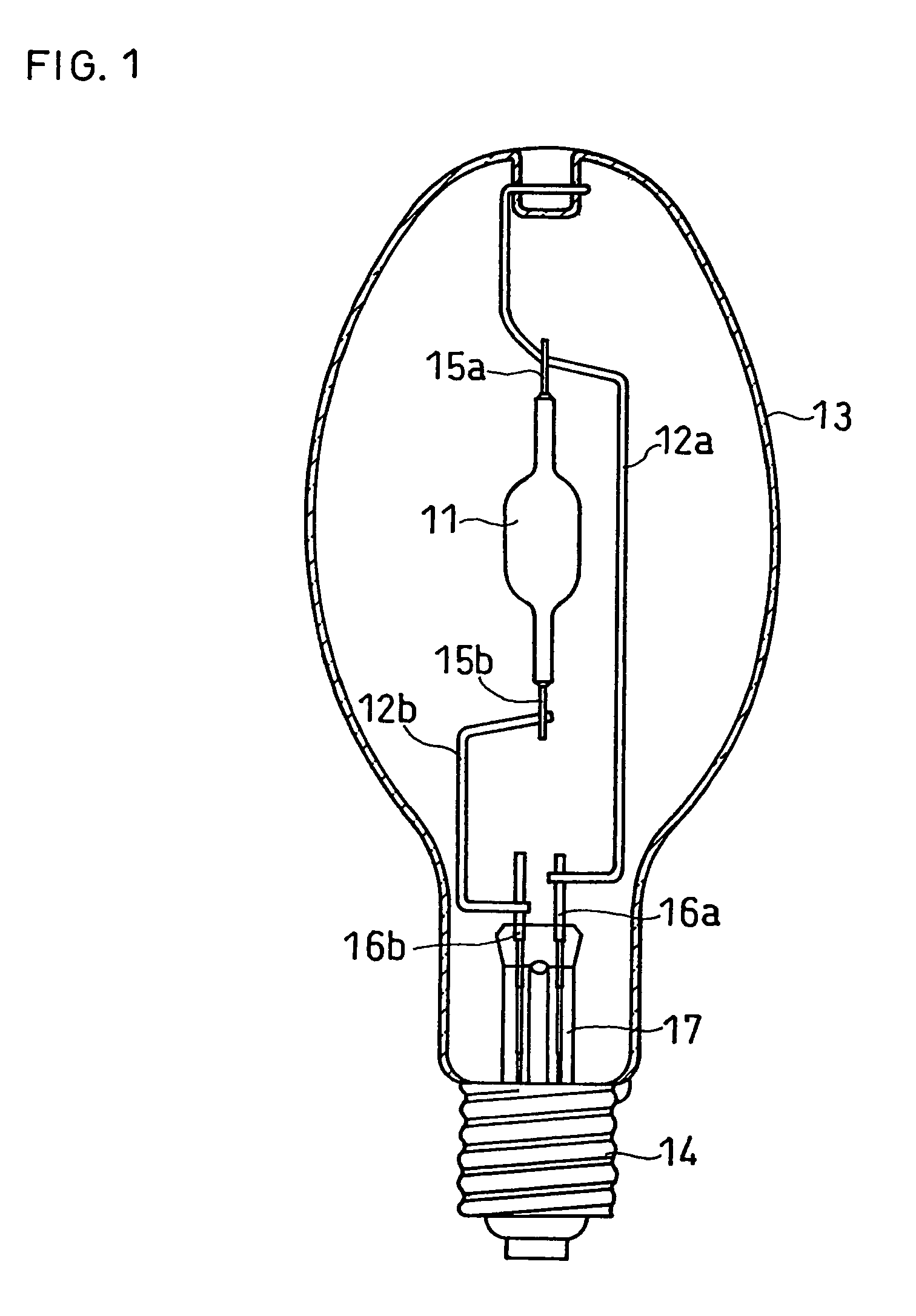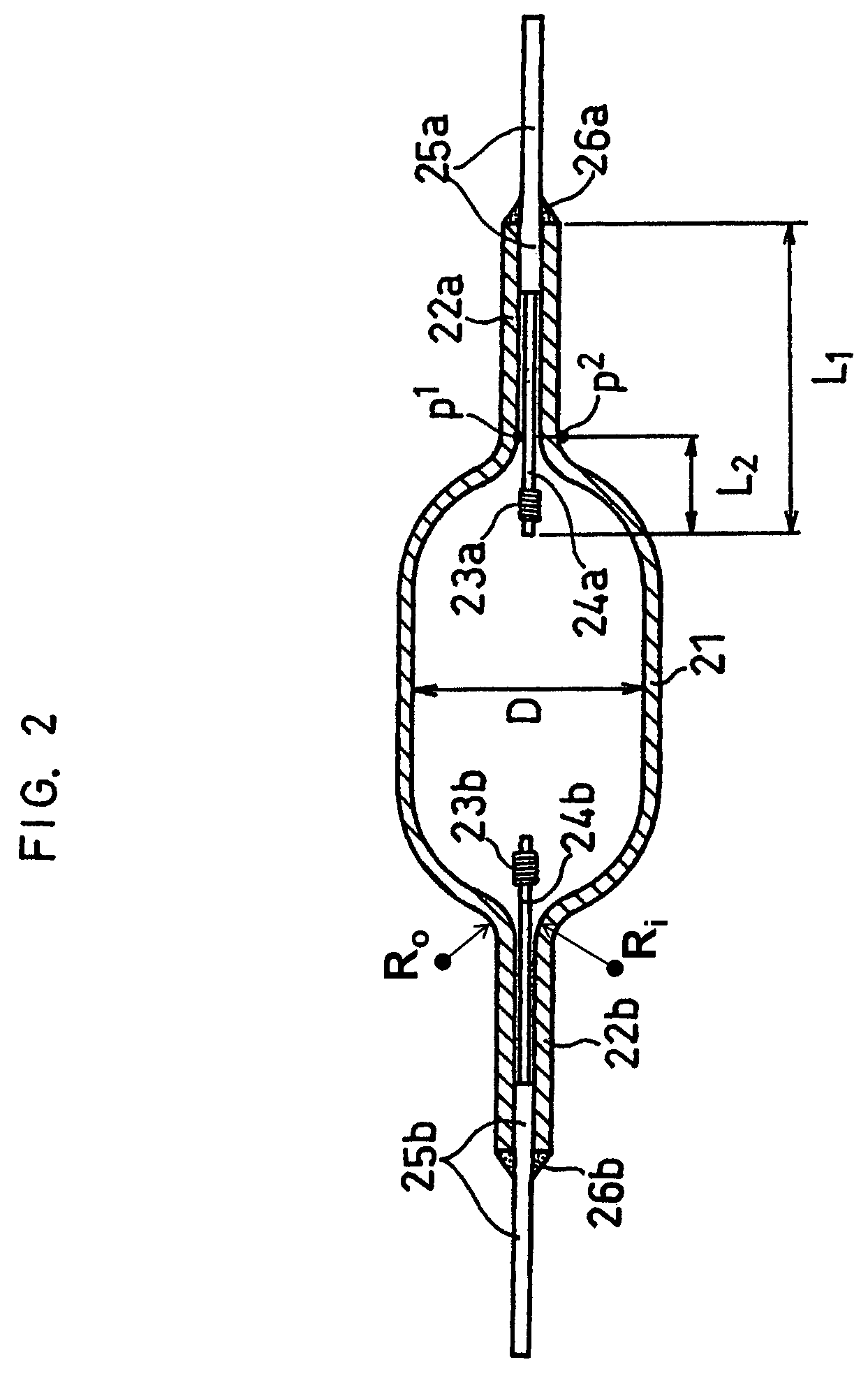Metal vapor discharge lamp having configured envelope for stable luminous characteristics
- Summary
- Abstract
- Description
- Claims
- Application Information
AI Technical Summary
Benefits of technology
Problems solved by technology
Method used
Image
Examples
example 1
[0029]A luminous tube having an envelope made of alumina ceramic as shown in FIG. 2 was produced, and using this tube, a metal vapor discharge lamp as shown in FIG. 1, with an electric power of 200 W, was produced.
[0030]Herein, a ratio (Ri / D) of the smallest curvature radius Ri (mm) of the inner wall of the boundary portion between the center bulb and each of the side tubes to the inner diameter D (mm) of the center bulb in the envelope was varied as shown in Table 1.
[0031]The inner diameter D of the center bulb was 12.9 mm and the inner diameter of each of the side tubes was 1.3 mm.
[0032]In the discharge space enclosed as light-emitting metals were 0.9 mg of DyI3, 0.7 mg of HoI3, 0.9 mg of TmI3, 2.8 mg of NaI and 0.9 mg of TlI.
[0033]In the discharge space further enclosed were 310 hPa of argon as a noble gas and 29.2 mg of mercury.
[0034]As for pin portions of electrodes used were pins made of tungsten, having an outer diameter of 0.6 mm and a length of 12.5 mm.
[0035]As for lead-in ...
example 2
[0040]Except that the lamp electric power was changed from 200 W to 300 W, a metal vapor discharge lamp was produced and then evaluated in the same manner as in Example 1.
[0041]However, the inner diameter D of the center bulb was 17.1 mm and the inner diameter of each of the side tubes was 1.3 mm.
[0042]In the discharge space enclosed as light-emitting metals were 2.3 mg of DyI3, 1.9 mg of HoI3, 2.3 mg of TmI3, 6.7 mg of NaI and 2.3 mg of TlI.
[0043]In the discharge space further enclosed were 310 hPa of argon as the noble gas and 56.4 mg of mercury.
[0044]As for the pin portions of the electrodes used were pins made of tungsten, having an outer diameter of 0.7 mm and a length of 17.8 mm.
[0045]As for the lead-in wires used was conductive cermet (thermal expansion coefficient: 7.0×10−6) having an outer diameter of 1.2 mm and a length of 40 mm, obtained by mixing a molybdenum powder with an alumina powder, and then sintering the mixture.
example 3
[0050]Except that the lamp electric power was changed from 200 W to 150 W, a metal vapor discharge lamp was produced and then evaluated in the same manner as in Example 1.
[0051]However, the inner diameter D of the center bulb was 12.0 mm and the inner diameter of each of the side tubes was 0.8 mm.
[0052]In the discharge space enclosed as light-emitting metals were 0.8 mg of DyI3, 0.6 mg of HoI3, 0.8 mg of TmI3, 2.2 mg of NaI and 0.8 mg of TlI.
[0053]In the discharge space further enclosed were 150 hPa of argon as the noble gas and 9.0 mg of mercury.
[0054]As for the pin portions of the electrodes used were pins made of tungsten, having an outer diameter of 0.5 mm and a length of 13.5 mm.
[0055]As for the lead-in wires used was conductive cermet (thermal expansion coefficient: 7.0×10−6) having an outer diameter of 0.7 mm and a length of 20 mm, obtained by mixing a molybdenum powder with an alumina powder, and then sintering the mixture.
PUM
 Login to View More
Login to View More Abstract
Description
Claims
Application Information
 Login to View More
Login to View More - R&D
- Intellectual Property
- Life Sciences
- Materials
- Tech Scout
- Unparalleled Data Quality
- Higher Quality Content
- 60% Fewer Hallucinations
Browse by: Latest US Patents, China's latest patents, Technical Efficacy Thesaurus, Application Domain, Technology Topic, Popular Technical Reports.
© 2025 PatSnap. All rights reserved.Legal|Privacy policy|Modern Slavery Act Transparency Statement|Sitemap|About US| Contact US: help@patsnap.com



